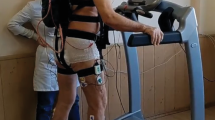Abstract
The aim of this study was to evaluate the modulation of muscle activity during locomotor-like movements by different walking speeds in subjects with a motor complete spinal cord injury (SCI) compared to actively- and passively-walking control subjects without neurological deficit. Stepping movements on a treadmill were induced and assisted by a driven gait orthosis. Electromyographic (EMG) muscle activity of one leg (rectus and biceps femoris, tibialis anterior and gastrocnemius) was recorded and analyzed at three stepping velocities with similar body weight support in both subject groups. In SCI subjects, the EMG amplitude of biceps femoris, tibialis anterior and gastrocnemius was in general similar or weaker than in passively- and actively-stepping control subjects, but that of rectus femoris was larger. The degree of co-activation between tibialis anterior and gastrocnemius was higher in SCI than in control subjects. A significant velocity-dependent EMG modulation was present in all four-leg muscles in both subject groups. In SCI subjects, this EMG modulation was similar to that in actively stepping control subjects. It is concluded that in complete spastic SCI subjects, spinal neuronal circuits underlying locomotion can to a large extent adequately respond to a change in external drive to adapt the neuronal pattern to a new locomotion speed. The application of various speeds might enhance the effect of locomotor training in incomplete SCI subjects.




Similar content being viewed by others
Abbreviations
- ANOVA:
-
Analysis of variance
- BF:
-
m. biceps femoris
- BWS:
-
Body weight support
- DGO:
-
Driven gait orthosis
- EMG:
-
Electromyography
- GM:
-
m. gastrocnemius medialis
- MF:
-
Modulation factor
- RF:
-
m. rectus femoris
- RMS:
-
Root mean square
- SCI:
-
Spinal cord injury
- TA:
-
m. tibialis anterior
References
Barbeau H, Rossignol S (1994) Enhancement of locomotor recovery following spinal cord injury. Curr Opin Neurol 7:517–524
Barbeau H, Julien C, Rossignol S (1987) The effects of clonidine and yohimbine on locomotion and cutaneous reflexes in the adult chronic spinal cat. Brain Res 437:83–96
Beres-Jones JA, Harkema SJ (2004) The human spinal cord interprets velocity-dependent afferent input during stepping. Brain 127:2232–2246
Bohannon RW, Smith MB (1987) Interrater reliability of a modified Ashworth Scale of muscle spasticity. Phys Ther 67:206–207
Bouyer L, Rossignol S (2003) Contribution of cutaneous inputs from the hind paw to the control of locomotion. II. Spinal cats. J Neurophysiol 90:3640–3653
Colombo G, Joerg M, Schreier R, Dietz V (2000) Treadmill training of paraplegic patients using a robotic orthosis. J Rehabil Res Dev 37:693–700
Colombo G, Wirz M, Dietz V (2001) Driven gait orthosis for improvement of locomotor training in paraplegic patients. Spinal Cord 39:252–255
De Leon R, Hodgson J, Roy R, Edgerton V (1999) Retention of hindlimb stepping ability in adult spinal cats after the cessation of step training. J Neurophysiol 81:85–94
De Luca C (1997) The use of surface electromyography in biomechanics. J Appl Biomech 13:135–163
Dietz V, Harkema S (2004) Locomotor activity in spinal cord-injured persons. J Appl Physiol 96:1954–1960
Dietz V, Müller R (2004) Degradation neuronal function following spinal cord injury: mechanisms and countermeasures. Brain 158:308–316
Dietz V, Colombo G, Jensen L, Baumgartner L (1995) Locomotor capacity of spinal cord in paraplegic patients. Ann Neurol 37:574–582
Dietz V, Wirz M, Colombo G, Curt A (1998a) Locomotor capacity and recovery of spinal cord function in paraplegic patients: a clinical and electrophysiological evaluation. Electroencephalogr Clin Neurophysiol 109:140–153
Dietz V, Wirz M, Curt A, Colombo G (1998b) Locomotor pattern in paraplegic patients: training effects and recovery of spinal cord function. Spinal Cord 36:380–390
Dietz V, Müller R, Colombo G (2002) Locomotor activity in spinal man: significance of afferent input from joint and load receptors. Brain 125:2626–2634
Dobkin B, Harkema SJ, Requejo PS, Edgerton VR (1995) Modulation of lokomotor-like EMG activity in subjects with complete and incomplete spinal cord injury. J Neurol Rehabil 9:183–190
Edgerton V, Tillakaratne N, De Leon R, Roy R (2004) Plasticity of the spinal neural circuitry after injury. Annu Rev Neurosci 17:145–167
Gomez-Pinilla F, Ying Z, Roy R, Hodgson J, Edgerton V (2004) Afferent input modulates neurotrophins and synaptic plasticity in the spinal cord. J Neurophysiol 92:3423–3432
Grillner S (1985) Neurobiological basis on rhythmic motor acts in vertebrates. Science 228:143–149
Harkema S, Hurley S, Patel U, Requejo P, Dobkin B, Edgerton V (1997) Human lumbosacral spinal cord interprets loading during stepping. J Neurophysiol 77:797–811
Hidler JM, Wall AE (2005) Alterations in muscle activation patterns during robotic-assisted walking. Clin Biomech (Bristol, Avon) 20:184–193
Jilge B, Minassian K, Rattay F, Pinter M, Gerstenbrand F, Binder H, Dimitrijevic M (2004) Initiating extension of the lower limbs in subjects with spinal cord injury by epidural lumbar cord stimulation. Exp Brain Res 154:308–326
Lünenburger L, Oertig M, Brunschweiler A, Colombo G, Riener R, Dietz V (2005) Assessment of spasticity with the robotic gait orthosis Lokomat. Brain Injury 19(Suppl 1):57
Maynard FJ, Bracken M, Creasey G, Ditunno JJ, Donovan W, Ducker T, Garber S, Marino R, Stover S, Tator C, Waters R, Wilberger J, Young W (1997) International standards for neurological and functional classification of spinal cord injury. American Spinal Injury Association. Spinal Cord 35:266–274
Pohl M, Mehrholz J, Ritschel C, Rückriem S (2002) Speed-dependent treadmill training in ambulatory hemiparetic stroke patients: a randomized controlled trial. Stroke 33:553–558
Yakovenko S, McCrea DA, Stecina K, Prochazka A (2005) Control of locomotor cycle durations. J Neurophys 94:1057–1065
Acknowledgements
This work was supported by the Swiss National Science Foundation (NCCR Neural plasticity and repair) and International Institute for Research in Paraplegia IFP (no. P59). The authors thank M. Stüssi and H. van Hedel for technical support.
Author information
Authors and Affiliations
Corresponding author
Rights and permissions
About this article
Cite this article
Lünenburger, L., Bolliger, M., Czell, D. et al. Modulation of locomotor activity in complete spinal cord injury. Exp Brain Res 174, 638–646 (2006). https://doi.org/10.1007/s00221-006-0509-4
Received:
Accepted:
Published:
Issue Date:
DOI: https://doi.org/10.1007/s00221-006-0509-4



